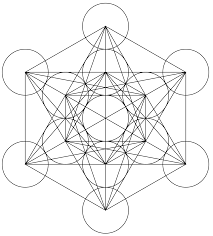
The familiar two dimensional image of Metatron’s cube is a good place to start to understand the complexity contained within it. Let's start with what is perhaps the most well known image, the triangle. You can look at the triangles and there are several of them, as being simply two dimensional or you can focus on the two point perspective that allows you to see a three dimensional image of a tetrahedron.
Let's start with a few simple definitions when talking about triangles. A triangle has three lines or three edges that connect at what is called a vertex. So, each edge connects with another edge at a vertex. When two lines come together, they form an angle. Angles are measured in degrees. In order for a triangle to be a regular triangle, all of its edges need to be the same length and all of its angles need to be equal.

Looking at the picture of Metatron’s cube we can see a very prominent, large triangle. You will notice it has three sides or three edges and it has three vertices and each vertex is equal to the other. So, we have a regular triangle. A regular triangle can also be referred to as a regular polyhedron which is a three dimensional representation of a triangle.
When you shift your perspective from two dimensional to three dimensional you can see that there is a another dimension that changes the triangle into a tetrahedron which is simply a three dimensional triangle. Looking at this picture, the backside of the triangle is drawn in perspective with the sides shaded.
A tetrahedron is said to be regular when each side is the same as the other sides and the sum of the angles is less than 360 degrees. I'm not trying to give precise geometric definitions here. I'm just trying to communicate the essence of these shapes.

This next picture shows the same tetrahedron with somewhat different shading on the sides. It might give you the sense that you are looking down at the tetrahedron. So, the picture can remain the same, but the perspective can shift.

Having identified the prominent regular triangle in Metatron's cube, you will notice that there is another prominent triangle that is inverted. That is to say, it's pointing in the opposite direction. These two regular triangles combine to form a star tetrahedron. Another name for the star tetrahedron is a Merkaba. I will have plenty more to say about Merkabas in an upcoming blog.

Now that you've connected two of the primary tetrahedrons, look more closely to find the smaller tetrahedrons that are closer to the center of the diagram. This next picture should help. You will also notice that there is a smaller Merkaba in the center of the picture. The smaller inverted tetrahedron is not shaded.
Triangles become pyramids or tetrahedrons and this first shape that we work with is important because several of the other platonic solids use the triangle in their construction. The octahedron has eight triangles for its faces and the icosahedron has 20 triangles for its faces. And technically, if you look at a square and draw a line diagonally across the square, you will see that it's comprised of two triangles. So, the triangle features very prominently within the platonic solids.
I just like to add that the circles in the first picture above are actually all individual Metatron’s cubes. Every Metatron’s cube is composed of several smaller Metatron’s cubes. And this repetition continues as a Metatron's cube gets smaller and continues as a Metatron's cube gets larger so that you can see that Metatron’s cube is really fractal in nature. And I'll discuss the fractal nature of the cube in more detail in a subsequent blog.
This is a beginning step in understanding the Platonic solids that are contained in Metatron's cube. It's important to understand that each of the Platonic solids exist in relation to each other. As we focus on each individual solid in the upcoming blogs, we will begin to understand the interactions among all of these shapes and that's where the true nature of the power that is contained within Metatron's cube exists.
I hope this brief introduction helps you to begin to see how much richer and fuller the third dimensional image of Metatron’s cube is when compared to the simple two dimensional image that's so familiar. Once you begin to envision Metatron's cube as three dimensional with all the three dimensional Platonic solids, I hope you will begin to see how vibrant and full of energy it really is.
Comentarios